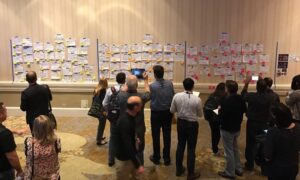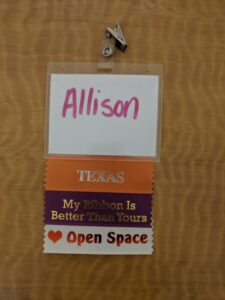
Open Space events can be a great way to organize a large group of people to quickly and effectively address the issues that matter to them. People often leave amazed at how much they learned or accomplished, especially when the event started with an empty agenda. You probably loved an event you attended and now are wondering how to facilitate open space with a large group. Open space can be used within a company or community conference.
Jake and I have both facilitated open space events with 100-1000+ attendees. There is a lot of preparation that goes into making the event go smoothly—in advance of the event and the day-of. There’s more to facilitating open space than walking around a circle and explaining the principles!
This article highlights three keys in how to facilitate a large open space event.
Mapping the Layout and Flow
Much of the pre-event preparation focuses on the physical space needs and logistics. For groups of 500+, we are in conference centers or hotel ballrooms and communicating with staff about furniture and audio needs. Open spaces are different than the banquet dinners and keynote presentations they host each week. Oftentimes we are relying on blueprints and a few photos of the rooms to make layout decisions.
How the chairs will be setup is one of the earliest decisions to be made, and the facilitator needs to coordinate with event organizers about it. Open space events typically have chairs for attendees arranged in a large circle or oval.

Some conferences have other activities scheduled before open space, and the room might be setup in a theater style or with round tables. I advise against expecting attendees to move furniture or rearrange chairs for the open space. If the room is in a theater layout, plan ample time for event staff or volunteers to reconfigure the room for accessibility needs. For rooms with rounds and chairs, a creative facilitator can walk between tables while opening the event.
Staff for one event raised the question of whether to have chairs (chairs won). Expecting hundreds of adults to sit on the floor did not feel inclusive. For over 100 attendees, one circle of chairs might not be large enough for everyone attending. A layout with rows of concentric circles is a nice alternative.
Enabling people to take part in open space means more than ensuring everyone has a chair. Look at where pathways can go so that people can get to a microphone, announce a topic, and then post it in the marketplace. Our suggestion is to have pathways be wide enough for two adults to pass by each other.
Placement of the Marketplace and Posters
A large group needs a large surface to post topics and view the whole marketplace. The goal is to make topics easy-to-view to avoid crowding and maximize visibility.
Looking at the room floor plan, identify what long, unobstructed walls are in the space. How close are they to where people may be entering and exiting the room? How much distance is between the wall and the area where attendees will be sitting? Consider how people will move around the room and what they will be able to see from their seats.

For the Scrum Gathering San Diego conference, we discussed mirroring the marketplace on two walls. When we arrived in person, we realized that we would have to settle for using only one wall. Wallpapers, columns, and other room challenges can mean adjusting plans just before the event.
Jake and I re-imagined the marketplace setup to use one wall and allow for someone to take photos of each session time. That layout enabled for sharing the marketplace on the ballroom projectors and social media. It’s become a favorite of mine. We modified the traditional grid layout so that all sessions at a given time could be in a camera frame. Sticky notes for locations can allow people to indicate the space for their topic. This avoided the format and readability challenges of a grid on the wall. It also made it easy for extra spaces to be identified and used.
The last room setup item to consider is placement of posters. Many facilitators like to have posters for the principles and law of open space. Many add posters for “butterfly” and “bumblebee” to explain common behaviors of open space attendees. Putting these around the ballroom and other locations can provide a visible reminder throughout the event.
Inviting Participation
Facilitating an open space can feel like taking a leap across a huge valley and hoping others will do the same. As Open Space founder Harrison Owen says, Open Space Technology itself requires “very few advance elements.” The key is to be present and focus on the group’s energy because the event is about them, not you as the facilitator.
The morning of the Scrum Gathering San Diego, Jake and I walked into the ballroom together. People were excited about the lightning talks. The cheesier the joke, the more they loved it. We leaned into being silly as facilitators and explained how the day would work. A friend helped demo how to propose a topic. People came up, formed lines at the two microphone stands, and announced topics. It went seamlessly.

At a different conference, attendees’ energy was lower. They’d watched a virtual speaker on a big screen and then taken a long coffee break. There were extra chairs to allow for distancing. The vibe was low-key. As a facilitator, I knew high energy silliness would not resonate here. A friendly and informal tone was a better fit. I described how the marketplace would work. It was in a far corner with lower ceilings. As I pointed “over yonder,” I invited the group to point with me. They played along like I’d hoped. They were ready to propose topics.
Telling people about the marketplace and how to propose sessions takes only a few minutes. Pausing to answer questions can bog things down and cause people to lose interest. A quick demo by a friend with a real topic to suggest can help people understand what to do. Some people will be ready to get a piece of paper before you’ve finished talking. Point out where people can line up to announce topics at a microphone stand, and then get out of the way.
Early Preparation Pays Off
Once the marketplace is populated, your job as facilitator is more than halfway done. You might be more tired after the opening that you expected! Jake and I nearly face-planted into our lunches at the Scrum Gathering San Diego as our adrenaline faded. We had been well-used in service of the group. Thankfully facilitators can relax once sessions are happening.
There are many details to plan in how to facilitate a large open space event. I focused on three key areas for open space facilitators to think about. They can help you and the group enjoy the open space.
Want more help?
Tell us about your open space event and facilitation needs! We are happy to answer questions or share more resources with you on how to facilitate a large open space.







